#he is often described as a conqueror seeking world domination
Text
Time for another poll 👀
#since I often discuss here that one of Ganondorf’s big motivations for conquering Hyrule is that#he doesn’t want to be a vassal#but what if that was a non issue#would he want to#would he still have that need to do it#he is often described as a conqueror seeking world domination#but his endeavors are usually confined to Hyrule#of course that is because of game design we don’t have land outside of hyrule#but! its fun to think of what that implicates lore-wise#ganonthots
47 notes
·
View notes
Text
Stages of the Zodiac Signs
STAGES OF ZODIAC SIGNS – a Lifespan’s Evolution
The common symbols of the Zodiac Signs, actually describe the first step, the first stage of your evolution. What few know is that this is only the beginning. You evolve. As life goes on, these stages change. Although you still keep your former stage in your heart, you progressively lose touch from it. Hence, as inevitably you attract new stimuli, you change. The only question is towards what? These are the Stages of Zodiac Signs. This is what you should expect.
Stages of Aries: Ram, Shephard, Reborn Sun
The Ram. This is the symbol everyone knows about this zodiac sign. People born under its influence are passionate, conquerors and natural fighters. The Ram is a sacred symbol of many Solar Deities. It shows the potential. A hidden fire within, ever-burning. However, as they grow up, they realize that they engage in too many fights. And worse, not all fights are victorious. They have many casualties and they’ve been reckless and irresponsible. Hence, at some point of their lives, they see the loss. This is why they become…
The Shephard. Grasping the Truth for the first time, they see how pointless it is to engage in rageful quarrels. Their awareness expands. They see what a Shephard sees. A never ending battle which is called life. This is when they turn into themselves. A turning point of their lives. However, it’s not an easy one. You see, a Shephard is lonely, isolated. He is a hermit. At this point, Aries needs time. Time to realise their true potential lies in their passion and not rage. This is when they turn their fire into…
Reborn Sun. Aries is the first symbol of the Zodiac Circle. Why? Because that is when Nature resurrects from the Death of Winter. In Ancient Egypt, this is the symbol of Aries. The Reborn Sun, symbolizing the Death(s) an individual has to go through, in order to realise his/her true potential. Once you let go of pain, sorrow and rage, you will be reborn with this Ultimate Stage of Aries.
Stages of Taurus: Bull, Minotaur, Demigod
Bull. Taurus, is symbolized by a Bull. But what is the occult meaning of this symbol? The Bull is a sacred animal in many ancient religions (Egyptian, Indian, Greek). Hence, the Bull symbolized the potentials of Nature. Spring is there and its fierce. Nothing can stop it. There is only one way and this is forward; exactly how a Bull sees its world. However, quite often, due to their lack of ability to see other options, they crash on walls. Those are the obstacles a Taurus is programmed to break and not to surpass. Gradually, they see that they cannot assert their dominance to other people. This is when they become…
Minotaur. This legendary beast, half human with the head of a Bull, is a personification of our instinctive passions which, some times, we think are incompatible with human nature. Shame is a deadly foe. Hence, the Minotaur, haunted by shame and regrets is more stubborn. This is when they are lost in the Labyrinth. Let me remind you that this legendary creature was lying in the dark chambers of a Labyrinth, guarding it. Hence, at this point of their lives, they are enraged, more stubborn than ever, but lost in the dark. This is when Taurus loses hope until they realize, that they’re lost in the Darkness because they chose to! This is when all this power enlightens their spirit, break down the labyrinth and become…
Demigod. This is no sugar-coating it. They truly become divine. Once they sense how powerful their spirit is, they channel it and create miracles. At this point of their lives Taurus perceives his/her power and liberates himself/herself from the boundaries of the physical Realm. However, they still cast miracles on Earth, enjoying satisfaction and beauty, guilt-free.
Stages of Gemini: Twins, Ship, Stars
Twins. The first step of Gemini’s life is drenched with curiosity and love for new experiences. Hence, they seek new stimuli and, as they grow up, they (often successfully) engage in different activities, adopt diverse theories and work in many fields, as if they sense that time is not enough. However, at some point, they realise that there is an empty space in their heart. This comes after a loss, at young age. Hence, they become…
Ship. As the Myth of Gemini tells us, the twin brothers joined the magical quest to find an amazing treasure. Hence, this symbolizes the stage of Gemini when they are bored from their way of living and seek the bigger truth. This quest, however, may be lonely and disappointing, at some point. Hence, most Geminis return to phase one – Twins. However, if they let go of this disappointment, they become…
Stars. This is the final stage of the Zodiac Sign. Once they realise that their inner curiosity for knowledge is simply lust for life, they accept failures and disappointments, they let go of pain and they move forward, expanding their awareness and become a true source of Light. They become Stars!
Stages of Cancer: Crab, Hydra, Peacock
Crab. This is the symbol everyone knows. A creature of the Sea, symbolizing the ‘watery’ nature of this zodiac sign. Due to their rich emotions, they do not always ‘move’ in a logical way, just like the crab doesn’t move in a straight line. Hence, as the sea is never the same, Cancer’s heart changes according to their stimuli around them. However, there are times when the crab’s strong exterior (devotion and loyalty) is crashed by cruelty and betrayal. This is when they become…
Hydra. Hydras are creatures of the sea, symbolizing (sea’s and) Cancer’s blind rage. When you cut the head of hydra, two more sprout out. Unfortunately, this shows that when they feel broken they can do terrible things. Trying to stop them is like trying to stop a huge wave of the ocean. It’s pointless. This is a very common stage of Cancer. They change, once they realise that as the Sea is vast, so are the people. Some are mean and hurtful, some are true and loyal. This is when their faith is restored and they become…
Peacock. This is the sacred symbol of Great Mother, Hera, Queen of the Gods. At this stage everyone adores them. Although they don’t intentionally show off, their actions speak for themselves. They are Grace and Blessings impersonated.
Stages of Leo: Lion, Warrior, King
Lion. At first, a typical Leo is born to feel like being the king of the jungle. As if their world belongs to them, inherited by the divine forces. Leo is strong, faithful and passionate. However, at some point in their lives, their authority is questioned and this is when things turn wrong. Rage fills their heart, when they sense that someone can out-throne them. This is when they become…
Warrior. At this point, all their energy is focused to prove themselves worthy. But worthy of what? What are they fighting for? For many years of their lives they are noble fighters in a war they did not choose. They are lost in elusive goals and spend their energy for silly tasks and quarrels. In truth, they fear time. Time is a threat to them because their beauty and splendour might fade. They become prideful and vain. But when they realise that the power comes from their bright spirit, they become…
King. At this point they know that being a lion is being a king in a jungle. But they are so much more. This is when they realize their royal self. An ageless spirit, a never ending reign of their light. At this point they are full of love and understanding.
Stages of Virgo: Maiden, Dark Maiden, Queen
Maiden. During their very first step in life, Virgo is the young Persephone, a young maiden goddess playing and experiencing her potential. Innocent, brilliant and graceful, the Maiden seeks the truth, while discovering herself on this Realm. However, at some point of their lives, as Persephone was kidnapped, Virgo is forced to travel to the Underworld.
Dark Maiden. At this point Virgo is scared and sad. Although it might not show, they hide a huge sorrow in their hearts. But what is this all about? Most of the times, their sadness is rationalized by their need to put their minds in order. At this time of their lives, they are lost in the darkness of their Underworld. Many Virgos pass a long time suffering from depression. However, if they manage to forgive and accept the world as it is, just like Persephone, she marries the God of Underworld, Hades, and she become…
Queen. At this stage, Virgo is capable of anything. They accept the truth of the world, that there is both Light and Darkness and they rule on both because of their crystal spirit. Hence, they are whole.
States of Libra: Scale, Blindfold, Sword
Scales. The first step of Libra is being the Scales of Themis, goddess of Justice. Always trying to see all options, hear all opinions and take all possible advices. This is why they seem dependent on others and indecisive. What others see as lack of guts, is actually a very powerful procedure when they try to scale all options and be fair and just. However, as they cannot easily proceed in their lives this way, they become…
Blindfold. Enraged and disappointed, they no longer wish to be just, because their energy is depleted. Hence, they make unnatural choices. This makes them feel bad for themselves. Hence, the Blindfold (of Themis). Virtue is no longer their guide. Once they understand that everyone makes mistakes, but it’s important to follow their instincts and heart, regardless, they become…
Sword. The Sword (of Themis) is the personification of right decisions and power. At this point, nothing can stop them and their spirit is aligned with their will. What they think of, becomes reality!
Stages of Scorpio: Scorpion, Eagle, Phoenix
Scorpion. The first step of their lives are Scorpions. Born survivors, they integrate their instincts and passions, in a fervid way, to achieve what they want. Seeking success and satisfaction, they often succeed, but, sometimes, they don’t. When this happens they descend in darkness, as scorpions hide under stones. At this point, some of them might stay forever. Others, they realise their pointless pursuits and they become…
Eagle. When this happens, Scorpions realise that they no longer need to hide, but they need to see the bigger picture and seek different types of success and satisfaction. Hence, at this point of their lives, they realise that they can seek both satisfaction and success elsewhere in life. As eagles, they fly higher and higher. Do you know who flies as high as an eagle does? No-one! This is when they realise how lonely they become. Failure is part of being human, and neglecting their human nature is not a wise choice. Hence, they become…
Phoenix. At this point of their lives, their Spirit shines like never before. Accepting and letting go of hurtful memories, they realise their true potential. The Phoenix is eternal and made of the material the Gods are created from. Hence, they realise how powerful they truly are. Nothing can stop them now!
Stages of Sagittarius: Archer, Arrow, Centaur
Archer. The first step in their lives, they feel that sky is the Limit. Sons and Daughters of Jupiter, they sense that a divine hand is guiding them. As archers, they aim and keep on aiming, again and again. They are optimistic. However, when eventually failure comes, they sometimes lose their sense of balance. They can become hurtful as an…
Arrow. Although they still aim, they have focused so much to their goal they neglect to see the bigger picture. What they need to understand is that succeeding is not always winning. Hence, what once they thought they can conquer, now can be useless. This is when they need to expand their awareness and review their goals. As they thirst for freedom, they realise that they have imprisoned themselves! If they bravely see the truth, they can become…
Centaur. This legendary creature is the personification of freedom, will, wisdom and human strength. Hence, at this point, a Sagittarius becomes a truly wise and successful person, a teacher for all of us. Transcending the human capabilities, the Centaur conquers his/her goals with ease and style!
Stages of Capricorn: Goat, Cave, Horn of Plenty
Goat. The first and most known symbol is the Goat. A earthly creature which might not be as magnificent as the Lion, yet people depend on them for many, many reason. This is exactly like a typical Capricorn. People depend on them, and they are trustworthy and hard-workers. However, as they grow up, they feel that people might use and abuse them. This is when they turn to their…
Cave. At this point of their live, they try to isolate themselves from toxic people and relationships. However, they cut off not only baneful relationships, but, also, healthy ones. As Amalthia, the Goat-nymph who nurtured Zeus in a cave, Capricorns usually seek this isolation as they feel endangered. On their way to the top, they lose touch with people whom once they loved. Thankfully, some of them realise that, and they become…
Horn of Plenty. The symbol of the Amalthia is the Cornucopia, the Horn of Plenty. At this point of their lives, they realize that true riches come from abundance as a state of mind. Hence, they become truly rich in all possible ways, enjoying both material and spiritual goods!
Stages of Aquarius: Cupbearer, Eagle, Angel
Cupbearer. The first step of their lives is when they feel alienated from other, because of their true self. Hence, they become eccentric, trying to communicate their differences in a plain, sad and boring world. The Cupbearer is dragged on Mount Olympus, stranger to all. However, once an Aquarius accepts the World, becomes the symbol of Zeus…
Eagle. At this point of their lives they need to experience the whole world. Hence, they (want to) travel everywhere, see more, feel more, understand more. As this is noble, yet also, at some point, impossible, they might feel lonely and separated from all. A lonely eagle flying high. This is when they need to realize that they cannot feel the same way others do, because they are indeed an…
Angel. Some of them realize their true Angelic nature and embrace it. These are the enlightened creatures who walk amongst us, shedding light in to the darkest places of Earth. Healers, helpers, divine instruments. They are both successful and truly happy, having found their rightful place on Earth.
Stages of Pisces: Fish, Darkness, Ocean
Fish. The first step of their lives they feel like a fish in the vast ocean. Affected by the ever moving waves, they live in their matrix of emotions (sea) and energies around them. As true empaths, they are influenced by enlightened souls, but also by evil entities. Hence, they sometimes get lost into disappointing thoughts, and sadness kicks in. This is when they become…
Darkness. Pisces often feel betrayed and lost, and they don’t know what to do. In order to not hurt others, they seek to forget, so they won’t feel pain anymore. As the fish descends to the darkest depths of the sea, they wait there for a miracle to happen. Then, sometimes, they realise that the miracle is already there. As their Spirit is otherworldly bright, they gracefully accept their true nature and become…
Ocean. This when they embrace the matrix as part of themselves and become the primordial god of Ocean. Hence, at this point, they know that power comes from their heart, and what they want can instantly happen, as they are part of something greater and wiser. They are the vast and rich ocean!
Blessed be.
Originally shared on Facebook by Violet Goddess
92 notes
·
View notes
Link
The Javanese state that flourished throughout the 14th and 15th centuries is often called the ‘Majapahit Empire’. But was it really an empire, and what does the word ‘empire’ mean in premodern Southeast Asia? This article surveys the evidence that can help us answer these questions. This evidence includes a handful of government inscriptions from east Java, Bali and Sumatra, two Javanese chronicles called the Deśavarṇana and the Pararaton, the official records of the Ming court, and the account of a Portuguese apothecary who visited Java in the early 16th century.
The Shadow of Singhasari (1255–92)
Before Majapahit was established as its new capital in 1293, the kingdom of Java had already begun to exercise its authority on other islands. Majapahit’s predecessor court, Singhasari, had begun to extend its influence beyond Java during the reign of Rājasa (1222–47). According to the Mūla Malurung inscription issued in 1255: ‘His Majesty [Rājasa] served as a single parasol for the world, the whole island of Java as well as the other islands’, the parasol being a common symbol of sovereignty in Southeast Asia and the Indian ocean world.
This rather nebulous assertion of authority was made concrete by a mighty Singhasari king called Kṛtanagara (1268–92). Two chronicle sources pay close attention to Kṛtanagara’s career: the 14th-century Deśavarṇana and the 16th-century Pararaton. Both of them depict Kṛtanagara as a militant ruler whose successful wars against Sumatra (1275) and Bali (1284) brought these regions under his personal dominion. Kṛtanagara was said to be an adept of Tantric practices, many of them aimed at boosting his supernatural powers. The Deśavarṇana describes his military victory over the Sumatran kingdom of Malayu as being ‘a result of his divine manifestation’ (41.5d).
Kṛtanagara’s success in subjugating various kings outside Java is illustrated by the Padang Roco inscription in central Sumatra (issued in 1286), which refers to him as the ‘great king of kings’ (mahārājādhirāja). He was apparently the overlord of the Sumatran king Maulivarmadeva, who in this inscription is merely a ‘great king’ (mahārāja). Historians today suspect that Kṛtanagara’s disruption of the power balances in the archipelago earned him the enmity of Kublai Khan, the Yuan Emperor in China.
These sources show that the Javanese king Kṛtanagara had been recognised as the overlord of certain kings on other islands in the late 13th century. The legacy of Kṛtanagara’s expansionist policies would be taken up by his Majapahit successors in the 14th century.
Majapahit’s Modest Beginnings (1293–1309)
Majapahit became the capital of Java in 1293, after a convoluted power struggle between several Javanese factions, an army from the neighbouring island of Madura, and even an expedition sent from China by the Khan. The eventual victor was a new king called Vijaya, who cut a rather less impressive figure than his predecessor Kṛtanagara.
The Kudadu inscription (issued in 1294) claims that Vijaya is simply ‘the lord of the whole island of Java’ (1b). The Sukhāmṛta inscription, issued two years later, again describes Vijaya as ‘the lord of all Java’, but more importantly, it describes Kṛtanagara as having once been ‘the king of the kings of Java, extending as far as the kings of the other islands’ (6b.2). The difference is clear. Kṛtanagara was the conqueror who defeated and ruled over foreign kings, while Vijaya controlled only Java.
The Balawi inscription (issued in 1305) describes Vijaya as ‘the sole ruler of the whole of the circle of Java’ and ‘the one whose throne is ornamented by the hair of the kings of the outer islands’ (1b.5). In this inscription, Vijaya compares his four wives (Kṛtanagara’s daughters) to four islands: ‘in their character they are just like Bali, Malayu, Madura, and Tanjung Pura’ (2a.2). We know from the usage in the later Deśavarṇana that Malayu is being used here as shorthand for the island of Sumatra, and Tanjung Pura for Borneo. The Balawi inscription also reiterates the fact that it was Kṛtanagara, not Vijaya, who ‘had his lotus feet kissed’ by kings of the other islands, ‘especially by the king of Bali’ (2a.4).
The shadow of Singhasari loomed large over the first Majapahit king. We see from these inscriptions that Vijaya’s own claim to sovereignty over the other islands was vague, and that he preferred to look back to the imposing precedent set by Kṛtanagara’s overseas campaigns.
We also know that Vijaya’s claim to rule ‘all of Java’ was an exaggeration. The later historical sources (Pararaton, Rangga Lawe and Sorāndaka) narrate how Vijaya spent most of his reign trying to deal with uprisings by his former comrades who had become dissatisfied with his leadership. Shortly after 1300, the king was forced to give up half of his Javanese territory to a Madura-based ruler called Vīrarāja, an erstwhile ally who had helped to put him on the throne in the first place. Vijaya died in 1309, with much of his own kingdom in open rebellion against him, having no real capacity to continue Kṛtanagara’s imperialist agenda in the archipelago.
Consolidating the Heartland (1309–28)
Vijaya’s successor Jayanagara spent the years between 1309 and 1323 dealing with the challenges to Majapahit authority in Java itself. Little is known about Java’s relationship with other islands during this time. The next important piece of evidence for our inquiry is the Tuhañaru inscription (issued in 1323), which describes ‘the whole span of the island of Java, with its dependencies the islands of Madura, Tanjung Pura etcetera, which produces the effort and sacrifice of all people, who constantly pay homage to and worship the King’ (4a.3). This inscription articulates the relationship between Java and other islands as one of ‘dependency’ involving obedience and homage to the Majapahit king. But it is still worryingly vague on which islands were included among these dependencies. Who exactly fell into the category of ‘et cetera’?
The chronicles show that Jayanagara’s reign was mostly preoccupied with domesticating eastern Java under Majapahit rule, a task he had largely completed by his early death in 1328. As the young king slowly consolidated Majapahit’s grip on the Javanese heartland, he became confident enough to start calling himself a ‘king of kings’ of Sumatra, Borneo, Madura and Bali, just as Kṛtanagara had done and Vijaya had not. What did Jayanagara’s claims of overlordship mean in practice? As yet, we have no evidence of specific military or diplomatic actions taken by the Majapahit court to enforce its theoretical sovereignty over the other islands.
One Oath To Rule Them All (1331–57)
Things changed drastically when a queen called Gitārja and her prime minister Gajah Mada took control of Majapahit in 1329. According to the Pararaton (p. 28), Gajah Mada swore an oath in 1331 to ‘defeat the outer islands: Gurun, Seran, Tañjung Pura, Haru, Pahang, Ḍompo, Bali, Suṇḍa, Palembang, Tumasik’. This is the famous Palapa Oath that Indonesian schoolchildren learn about. It is often paraphrased in Indonesian as a promise to ‘unite the archipelago’ (menyatukan tanah air), but that is not an accurate translation, because the Old Javanese text simply means ‘the other islands are defeated’ (kālah nūṣāntara). The places mentioned in the oath are very far-flung: Pahang is on the Malaysian peninsula, while Ḍompo is on the island of Sumbawa.
The Pararaton was compiled sometime in early 16th century, so it is not a contemporary source for Gajah Mada’s oath. We can’t know whether he really said such a thing. But the list of military targets in the oath matches closely the list of tributaries claimed by Majapahit in the Deśavarṇana. An interesting detail given in the Pararaton is that when Gajah Mada made this oath, the other ministers laughed in his face. Even if this is just a creative embellishment, it illustrates how extravagant the project must have sounded to his contemporaries.
We know that Gajah Mada’s words were followed up with action. The Deśavarṇana (49.4a) states that Java attacked Bali in 1343 and deposed its monarch. North Sumatran inscriptions and chronicles suggest that the same thing happened at Pasai shortly before 1345. Javanese foreign policy during the 1330s and 1340s seems to have consisted of something like this:
1) demand obedience and tribute from kings on other islands,
2) launch a military strike on those who refused the demand,
3) replace them with rulers who would be more loyal,
4) withdraw the military force until the next time it was needed.
From what we can tell from the chronicles, Gajah Mada’s military campaigns were more successful and wide-ranging than those of Kṛtanagara. Majapahit’s overseas power had finally eclipsed that of Singhasari.
In Praise of the Majapahit Emperor (1365)
The definitive claim of Majapahit dominance over the archipelago is found in the Deśavarṇana. This text is a blend of chronicle, royalist propaganda, and personal memoir, written by a Buddhist cleric in 1365. The poem dedicates Cantos 12–16 to listing the overseas dependencies claimed by Java at the time. The Majapahit court is compared to the sun and moon, while the subordinate courts in Java and ‘all the peripheral countries on the other islands’ are like planets; they ‘seek shelter in and humbly approach’ the king (12.6).
Cantos 13–14 name these peripheral countries and group them into four: the Sumatran countries that ‘are dependent on’ Malayu, the Borneo countries dependent on Tanjung Pura, the Malay peninsula countries dependent on Pahang, and the miscellaneous countries to the east. The places mentioned go as far north as Langkasuka (modern-day Pattani), as far west as Lamuri (Aceh), and as far east as Wwanin (generally thought to be somewhere on the coast of West Papua). An extremely extensive area.
All these regions described as ‘being protected’ (15.1a), ‘paying homage’ (15.3a), ‘bringing gifts that appear every month’ (15.3b), ‘being guarded’ (16.5a), and ‘obedient to all the commands’ (16.5b) of the Javanese king. Majapahit’s method of enforcing this obedience is explained: ‘any that transgressed his commands was attacked and wiped out completely by groups of naval officers, who are variously decorated’ (16.5c–d).
When the other countries did comply with Majapahit’s demand for tribute, Javanese scholars and officers were sent specially to collect the tribute from these places (15.3). There is a statement that religious scholars were sent in order to ‘establish the doctrine’ of Śiva and Buddha in the outer islands, ‘so that there would not be deviation’ (16.1). Does this suggest a sort of religious domination too?
The Deśavarṇana is a dependable eyewitness account of the times, but its main purpose is to flatter the Majapahit king. How seriously can we take its enormous list of countries that were supposedly ‘obedient to all the commands’ of Java?
Ādityavarman’s Autonomy (1347–75)
There are some holes in the Deśavarṇana’s story of Majapahit supremacy. Enter Ādityavarman, a Javanese prince with possible Malay lineage who served as senior minister at Majapahit in the 1330s and early 1340s, apparently outranking Gajah Mada himself during this period. According to an inscription written on a statue of Manjuśrī dated 1343, Ādityavarman was a Buddhist and was a descendant of Kṛtanagara.
After years of service to Majapahit, Ādityavarman did something odd in 1347. He suddenly appeared in central Sumatra declaring himself the ‘great king of kings’, precisely the title Kṛtanagara had used as overlord of that region in 1286. Ādityavarman continued to issue inscriptions in Sumatra on his own authority up until 1375, apparently not acknowledging any loyalty to Java. During this time, he claimed descent from the old Sumatran Mauli dynasty, whom Kṛtanagara had subjugated back in 1275. One of Ādityavarman’s major inscriptions, the Amoghapaśa inscription (1347), is written on the back of a statue dedicated by Kṛtanagara in 1286. And just like Kṛtanagara, Ādityavarman was also interested in Tantric rituals to concentrate his mystical power.
The Deśavarṇana completely ignores Ādityavarman’s claims of autonomy. Instead it reports that his kingdom paid tribute to Majapahit, just like all the other countries in Sumatra. This discrepancy shows that the Deśavarṇana is prone to exaggerating the extent of Java’s hegemony, just as we saw in the inscriptions of Vijaya and Jayanagara in the early 14th century. It means that we can’t take its list of tributaries at face value, but neither can we reject the text’s claims completely.
The Massacre of the Sundanese (1357)
The massacre of the Sundanese, often referred to as the Bubat War, shows another side to Java’s strategy of domination. It is important to note before we start this section that the Majapahit sources almost always list Sunda as one of the ‘other islands’ and not a part of the island of Java. This confirms our impression that when Majapahit documents say ‘Java’, they mean only ‘where the Javanese speakers live’, i.e. central and east Java, whereas ‘Sunda’ means ‘where the Sundanese speakers live’, i.e. west Java.
According to the Pararaton (pp. 28–9), the Sundanese royal family was invited to Majapahit in 1357. They had come to attend a wedding between a Sundanese princess and the Javanese king Hayam Wuruk. Instead they were ambushed and killed by their Javanese hosts. The pretext for this massacre was a miscommunication: the Sundanese had come on the impression that Hayam Wuruk would take the Sundanese princess as his primary wife and acknowledge the equal status of the Sundanese dynasty to that of Majapahit, while the Javanese assumed the princess was being offered as tribute and would have concubine status.
The decision to kill the Sundanese was taken by Gajah Mada and the king’s uncle Kudāmṛta. Gajah Mada evidently viewed the destruction of the Sundanese royal family as fulfilling his promise to ‘defeat Sunda’. After the massacre, he declared that the Palapa Oath was a mission accomplished.
This story is found in the later Javanese sources Pararaton, Kidung Sunda, and Tatwa Sunda, and is also mentioned briefly in the Sundanese history Carita Parahyangan. Strangely, it is absent from all the 14th-century primary sources, such the Deśavarṇana and the inscriptions. Nevertheless, it is an integral part of the story of Gajah Mada’s oath to defeat the kingdoms of the archipelago. The incident shows that Majapahit supremacy was not easily accepted by other kingdoms, but remained an ongoing source of conflict throughout the 14th century.
The Character of Javanese Hegemony
How did Majapahit actually assert its dominance in the mid 14th century? It is plausible that Java could make long-distance naval strikes against other islands in the archipelago, as described in the Deśavarṇana. It is also likely that those countries sent tribute to Majapahit as a formal acknowledgement of superiority. But Java did not annex those countries, which are always called ‘other islands’ separate to Java. Madura was the only significant island ‘not included among the overseas palaces’, but rather, it was administratively ‘united with the land of Java’ (Deśavarṇana 15.2).
Bali was another somewhat special case. According to later Balinese tradition, Javanese nobles were sent to administer the island after the Majapahit invasion of 1343. The Batur inscription, issued in north Bali in 1384, records that a dispute between one of these nobles and a local community of blacksmiths was referred to the Majapahit court for adjudication.
The Javanese also had the final say in matters pertaining to southern Sumatra. In 1397 the Ming court in China was having difficulties with the Sumatran country they called San-fo-qi, and asked the Javanese to settle the matter because ‘San-fo-qi is subject to Java’ (Ming Shi-lu, 18 September 1397). This is further evidence for the Majapahit court being acknowledged as the highest political authority in this central part of the Indonesian archipelago.
The Majapahit rulers preferred to install obedient local rulers in distant islands, rather than administering them directly. They were sometimes asked to intervene in some domestic problem, suggesting the Majapahit court was seen as having overall responsibility for settling disputes in the region. When these local rulers asserted their autonomy, such as at Pasai and in Bali in the 1340s, or at Palembang in the 1390s, the Javanese deposed them and put in someone they liked better. But this was not always possible. Ādityavarman in central Sumatra seems to have been able to avoid any punishment for defying Majapahit, and it was only after his death in 1375 that the Javanese attempted to reimpose their authority in his kingdom.
Memories of Majapahit
The Malay regions preserved traditions about Majapahit domination for a long time. Between 1513 and 1515, the Portuguese apothecary Tomé Pires recorded oral histories about the foundation of Melaka, the leading Malay kingdom at the turn of the 16th century. Pires’ notes were compiled in a document called the Suma Oriental, which has proved an invaluable source for the history of Southeast Asia in this period.
Pires’ sources claimed that around 1400, a Majapahit king called ‘Batara Tamarill’ had as his vassals the kings of Palembang and of Singapore. The son of the Palembang king married into the Majapahit royal family, but ‘when he realised how nobly he was married and how great was his power in the neighbouring islands which were under his brother-in-law’s jurisdiction, he rose against the vassalage and obedience’ (Pires, p. 231). The king of Majapahit sent a punishing expedition that took control of the island of Bangka and then drove his disobedient vassal out of Palembang and forced him to flee to Singapore, after which he ended up founding the Melaka kingdom. This event shows that as late as 1397, Majapahit was still effectively able to enforce its claims over its overseas dependencies.
But the evidence for Javanese hegemony peters out in the 15th century. The Javanese kings continued to refer to themselves as ‘king of kings’ in inscriptions dated 1447, 1473 and 1486, but they no longer talked about the other islands specifically. No further military adventures are mentioned in the chronicles. In the latter half of the 15th century, Javanese shipping slowly passed out of Majapahit’s control and into the hands of the autonomous Muslim-ruled towns on the north coast of Java.
Pires was told that Java ‘used to rule as far as the Moluccas and over a great part of the west, and … almost all of Sumatra, until about a hundred years ago [i.e. until the 1410s], when its power began to diminish’ (p. 174). This account is broadly consistent with what we know from the other sources about Majapahit’s claims of hegemony in the period 1330–1400 and its apparent weakening in the 15th century.
What’s in an Empire?
After all this, can we say that Majapahit was really an empire? The answer depends on what we mean by the word. If being an empire means the direct administration of provinces, permanent military occupation, and the imposition of political and cultural norms over a wide area, then Majapahit was probably not an empire. Javanese rule over the other islands was too intermittent and too indirect to qualify by those criteria.
But if being an empire means the projection of military power at will, formal acknowledgement of overlordship by vassals and third parties, and the regular delivery of tribute to the centre, then Java’s relationship to the archipelago can well be considered an imperial one, especially during the late Singhasari (1268–92) and middle Majapahit (1330–1400) periods. At other times, such as early Majapahit period (1293–1330) and the late Majapahit period (after 1400), the Javanese dream of an overseas empire is much less credible.
19 notes
·
View notes
Text
Satan
Some claim that there is no such being, the devil; but after observing the evil that exists in the world, it is logical to ask: "Who continues to do the work of Satan during his absence, if he does not exist? The scriptures reveal to us:
1. Its origin.
Read Isa. 14: 12-15; Ezeq. 28: 12-19. The popular conception of a horned, crowbar, and horrible-looking devil had its origins in pagan mythology and not in the Bible. According to Scripture, Satan was originally Lucifer (literally, "the one who brings light"), the most glorious of angels. But he proudly aspired to be "like the Most High" and fell into "the condemnation of the devil" (1 Tim. 3: 6). Note the historical background in chapters 14 of Isaiah and 28 of Ezekiel. Many have asked, "Why are the kings of Babylon and Tyreus mentioned first, before the fall of Satan is reported?" The answer is: the prophet described Satan's fall for a practical purpose. Some of the kings of Babylon and Tire claimed worship as divine beings, which is blasphemy (See Dan. 3: 1-12; Rev. 13:15; Ezek. 28: 2; Acts 12: 20-23), and did of his subjects the game of his cruel ambition. In order to admonish those, the inspired prophets of God removed the veil from the dark past and described the fall of the rebellious angel, who said: "I will be like God." This is the practical lesson: If God punished the blasphemous pride of this high-ranking angel, how can he stop judging any king who dares to usurp his place? Notice how Satan sought to infect our first parents with his pride. (See Ge 3: 5; Isa. 14:14). Let us note how frustrated pride and ambition still consume him, to the point of wanting to be worshiped (Matt. 4: 9) as "god of this world" (2 Cor. 4: 4), an ambition that will be temporarily satisfied when he incarnates the antichrist. . (Rev. 13: 4.) As a punishment for his wickedness, Satan was cast out of heaven, along with a group of angels that he had enlisted in his rebellion. (Matt. 25:41; Rev. 12: 7; Ephesians 2: 2; Matt. 12:24.) He sought to win Eve as his ally; however, God thwarted the plan and said, "I will put enmity between you and the woman" (Gen. 3:15).
2. Your character.
The qualifications of Satan's character are indicated by the following titles and names by which he is known:
(a) Satan literally means "adversary" and describes his malicious and persistent attempts to obstruct God's purposes. This opposition was manifested especially in his attempts to thwart God's plan by seeking to destroy the chosen lineage, from which the Messiah would come - an activity predicted in Gen. 3:15. And from the beginning he has persisted in this struggle. Cain, Eve's first son, "was of the evil one and killed his brother" (1 John 3:12).
God gave Eve another son, Sete, who became the chosen seed from which the Deliverer of the world would proceed. But the venom of the serpent was still having an effect on the human race, and, over time, the lineage of Sete gave in to bad influences and deteriorated. The result was the universal wickedness that resulted in the Flood. God's plan, however, was not frustrated because there was at least one righteous person, Noah, whose family became the origin of a new race. In this way Satan's purpose of destroying the human race and impeding God's plan failed.
From Shem, son of Noah, Abraham, the progenitor of a chosen people, descended through which God would save the world. Naturally the enemy's efforts were directed against this particular family. One writer traces Satan's cunning opposition in the following incidents: Ishmael's opposition to Isaac, Esau's intention to kill Jacob; and Pharaoh's oppression of the Israelites. Satan is described as seeking to destroy the church in two ways: inwardly, by introducing false teachings (1 Tim. 4: 1; see Matt. 13: 38,39), and outwardly by persecution (Rev. 2:10).
This was the case with Israel, the Old Testament church of God. The worship of the golden calf at the beginning of its national life is a typical case that has constantly occurred throughout its history; and in the book of Esther we have an example of an effort made to destroy the chosen people. But God's chosen people have survived both the corruption of idolatry and the fury of the persecutor, and this is because of the divine grace that has always preserved a faithful remnant. When the time was up, the Redeemer came into the world, and the evil Herod planned to kill him; however, once again God prevailed and Satan's plan failed.
In the desert, Satan sought to oppose the Anointed One of God and divert him from his saving mission, but he was defeated; and his Conqueror "went about doing good, and healing all the oppressed of the devil." This secular conflict will reach its climax when Satan incarnates in the antichrist and is destroyed at the time of Christ's coming.
(b) Devil literally means "slanderer". Satan is called that because he slanders both God (Gen. 3: 2,4,5) and man (Rev. 12:10; John 1: 9; Zac. 3: 1, 2; Luc. 22:31) .
(c) Destroyer is the meaning of the word "Apollyon" (Greek), "Abaddon" (Hebrew) (Rev. 9:11). Filled with hatred against the Creator and his works, the devil wanted to establish himself as the god of destruction.
(d) Snake. "That ancient serpent, called the devil" (Rev. 12: 9) reminds us of the one who, in antiquity, used a serpent as his agent to bring about the fall of man.
(it's tempting. (Matt. 4: 3.) "Trying" literally means to prove or test, and the term is also used in connection with God's dealings (Gen. 22: 1). But, while God tests men for their own good - to purify and develop their character - Satan tempts them with the malicious purpose of destroying them.
(f) Prince and god of this world. (John 12:31; 2 Cor. 4: 4.) These titles suggest their influence on organized society outside or apart from the influence of God's will. "The whole world is in the evil one" (in the power of the evil one) (1 John 5:19) and is influenced by him. (1 John 2:16.) The Scriptures describe the world as a vast set of human activities, the trilogy of which is summed up in these words: fame, pleasure and goods.
To these three objectives everything is subordinate. Skillful arguments in defense of them create the illusion of being truly worthy. These objectives also enjoy the advantage of a vast literary, commercial and governmental apparatus, which constantly demands from the citizens of the world the cult of these objectives, which, in their minds, are associated with the highest values. The applause of the people is dedicated to those who succeed. The judgment of things is by the apparent aspect and success, based on false postulates of honor and by false ideas of pleasure, values and the dignity of wealth. Furthermore, there is a strong appeal to the lower instincts of our nature, a call that pretends to be in language (?)
3. Your activities.
(a) The nature of the activities. Satan disturbs the work of God (1 Thess. 2:18); opposes the Gospel (Matt. 13:19; 2 Cor. 4: 4); dominates, blinds, deceives and snares the wicked (Luke 22: 3; 2 Cor. 4: 4; Rev. 20: 7, 8; 1 Tim. 3: 7). He afflicts (John 1:12) and tries (1 Thess. 3: 5) the saints of God. He is described as presumptuous (Matt. 4: 4, 5); proud (1 Tim. 3: 6); powerful (Eph. 2: 2); evil (John 2: 4); cunning (Gen. 3: 1 and 2 Cor. 11: 3); deceiver (Eph. 6:11); fierce and cruel (1 Pet. 5: 8).
(b) The sphere of activities. The devil does not limit his operations to the wicked and the depraved. He often acts in the higher circles as "an angel of light" (2 Cor. 11:14). Indeed, he even attends religious meetings, which is indicated by his presence in the gathering of angels (John chapter 1), and by the use of the terms: "doctrines of demons" (1 Tim. 4: 1) and "the synagogue of Satan "(Rev. 2: 9). Often his agents pose as "ministers of justice" (2 Cor. 11:15). The reason that he attends religious meetings is his malicious attempt to destroy the church, because he knows that once the salt of the earth loses its flavor, man becomes a victim in his unscrupulous hands.
(c) the reason for the activities. Why is Satan so interested in our ruin? José Hussiein replies: "He hates the image of God in us. He hates even the human nature that we possess, with which the Son of God was clothed. He hates the external glory of God, for the promotion of which we have been created and for which we will achieve our own eternal happiness. He hates his own happiness, for which we are destined, because he himself has lost it forever. He hates us for a thousand reasons and he envies us. " Thus said an ancient Jewish scribe: "Out of the devil's envy death came into the world: and those who follow him are beside him."
(d) Activity restrictions. While recognizing that Satan is strong, we must be careful not to exaggerate his power. For those who believe in Christ, he is already a defeated enemy (John 12:31), and he is strong only for those who give in to temptation. Despite his roaring fury he is a coward, for James said, "Resist the devil and he will flee from you" (Aunt. 4: 7). It has power, but limited. he cannot try (Matt. 4: 1), afflict (John 1:16), kill (John 2: 6; Heb. 2:14), or touch the believer without God's permission.
4. Your destiny.
From the beginning God predicted and decreed the defeat of that power that had caused man to fall (Gen. 3:15), and the serpent's punishment to the dust of the earth was a prophetic glimpse of the degradation and final defeat of this "old serpent, the devil". Satan's career is always on the decline. In the beginning he was expelled from heaven; during the Tribulation he will be thrown from the heavenly sphere to the earth (Rev. 12: 9); during the Millennium he will be imprisoned in the abyss, and after a thousand years, he will be thrown into the lake of fire (Rev. 20:10). In this way, the Word of God assures us of the final defeat of evil. ... Satanãs
Alguns afirmam que não existe tal ser, o diabo; mas depois de observar-se o mal que existe no mundo, é lógico que se pergunte: "Quem continua a fazer a obra de Satanás durante a sua ausência, se é que ele não existe? As escrituras nos revelam:
1. Sua origem.
Leia Isa. 14: 12-15; Ezeq. 28: 12-19. A concepção popular de um diabo com chifres, pés de cabra, e de aparência horrível teve sua origem na mitologia pagã e não na Bíblia. De acordo com as Escrituras, Satanás era certo Lúcifer (literalmente, "o que leva luz"), o mais glorioso dos anjos. Mas ele, orgulhosamente, aspirou a ser "como o Altíssimo" e caiu na "condenação do diabo" (1 Tim. 3: 6). Notemos os antecedentes históricos nos capítulos 14 de Isaias e 28 de Ezequiel. Muitos têm perguntado: "Por que os reis da Babilônia e de Tiro são importantes, antes de relatar-se a queda de Satanás?" A resposta é: o profeta enunciadosu a queda de Satanás tendo em vista um propósito prático. Alguns dos reis de Babilônia e Tiro reivindicaram adoração como seres divinos, o que é uma blasfêmia (Vide Dan. 3: 1-12; Apoc. 13:15; Ezeq. 28: 2; Atos 12: 20-23), e faziam de seus súditos o jogo de sua ambição cruel. Para poder admoestar os tais, os inspirados profetas de Deus afastaram o véu do obscuro passado e descreveram a queda do anjo rebelde, que disse: "Eu ser igual a Deus." Esta é uma lição prática: Se Deus castigou o blasfemo orgulho desse anjo de tão alta categoria, como deixar de julgar a qualquer rei que se atreva a usurpar o seu lugar? Notemos como Satanás preparo contagiar nossos primeiros pais com o seu orgulho. (Vide Gên 3: 5; Isa. 14:14). Notemos como o frustrado orgulho e ambição ainda o consomem, um ponto de desejar ser adorado (Mat. 4: 9) como "deus deste mundo" (2 Cor. 4: 4), uma ambição que temporariamente será satisfeita quando ele encarnar o anticristo . (Apo. 13: 4.) Como castigo por sua maldade, Satanás foi lançado fora do céu, juntamente com um grupo de anjos que ele havia alistado em sua rebelião. (Mat. 25:41; Apoc. 12: 7; Efés. 2: 2; Mat. 12:24.) Ele espera ganhar Eva como sua aliada; porém, Deus frustrou o plano e disse: "Porei inimizade entre ti e a mulher" (Gên. 3:15).
2. Seu caráter.
As qualificações do caráter de Satanás são indicadas pelos seguintes nomes e nomes pelos quais é conhecido:
(a) Satanás significa literalmente "adversário" e ensaios seus intentos maliciosos e persistentes de obstruir os propósitos de Deus. Essa distinção se manifesta especialmente nas suas restrições ao plano de Deus ao procurar destruir uma linhagem escolhida, da qual viria o Messias - atividade predita em Gên. 3:15. E desde o princípio ele tem persistido nesta luta. Caim, o primeiro filho de Eva, "era do maligno e matou a seu irmão" (1 João 3:12).
Deus deu a Eva outro filho, Sete, que veio a ser a semente escolhida da qual procederia o Libertador do mundo. Mas o veneno da serpente ainda estava surtindo efeito na raça humana, e, no transcurso do tempo a linhagem de Sete cedeu às más influências e se deteriorou. O resultado foi uma impiedade universal da qual resultou o Dilúvio. O plano de Deus, não obstante, não foi frustrado porque havia pelo menos uma pessoa justa, Noé, cuja família se tornou origem de uma nova raça. Dessa maneira fracassou o propósito de Satanás de destruir a raça humana e impedir o plano de Deus.
De Sem, filho de Noé, descendeu Abraão, o progenitor de um povo escolhido, por meio do qual Deus salvaria o mundo. Naturalmente os esforços do inimigo se dirigem contra esta família em particular. Certo escritor traça a astuta indicada de Satanás nos seguintes incidentes: A nomeação de Ismael a Isaque, a intenção de Esaú de matar Jacó; e a opressão de Faraó aos israelitas. Satanás é descrito como procurar destruir a igreja, de duas maneiras: interiormente, pela introdução de falsos ensinos (1 Tim. 4: 1; vide Mat. 13: 38,39), e exteriormente pela perseguição (Apoc. 2:10).
Foi o que se verificou com Israel, a igreja de Deus do Antigo Testamento. A adoração do abaixo de ouro no princípio de sua vida nacional é um caso típico de ocorrências ocorridas de toda a sua história; e no livro de Ester temos o exemplo de um esforço feito para destruir o povo escolhido. Mas o povo escolhido de Deus tem sobrevivido tanto à corrupção da idolatria, quanto à fúria do perseguidor, e isso por causa da graça divina que sempre tem preservado um restante fiel. Quando se cumpriu o tempo, o Redentor veio ao mundo, e o malvado Herodes planejou matá-lo; porém, mais uma vez Deus prevaleceu and the plan of Satanás fracassou.
No deserto, Satanás espera opor-se ao Ungido de Deus e desviá-lo de sua missão salvadora, porém foi derrotado; e seu Conquistador "andou fazendo o bem, e curando a todos os oprimidos do diabo". Este conflito secular chegará ao seu clímax quando Satanás se encarnar no anticristo e for destruído na ocasião da vinda de Cristo.
(b) Diabo significa literalmente "caluniador". Satanás é chamado assim porque calunia tanto a Deus (Gên. 3: 2,4,5) como ao homem (Apoc. 12:10; Jo 1: 9; Zac. 3: 1, 2; Luc. 22:31).
(c) Destruidor é o sentido da palavra "Apollyon" (grego), "Abaddon" (hebraico) (Apoc. 9:11). Cheio de ódio contra o Criador e suas obras, ou diabo desejava estabelecer-se como o deus da destruição.
(d) Serpente. "Essa antiga serpente, chamada o diabo" (Apoc. 12: 9) nos faz lembrar aquele, na antiguidade, como uma serpente como seu agente para ocasionar uma queda do homem.
(e) Tentador. (Mat. 4: 3.) "Tentar" significa literalmente provar ou testar, e o termo é usado também em relação aos tratos de Deus (Gên. 22: 1). Mas, enquanto Deus põe à prova os homens para seu próprio bem - para purificar e desenvolver o seu caráter - Satanás tenta-os com o propósito malicioso de destruir.
(f) Príncipe e deus deste mundo. (João 12:31; 2 Cor. 4: 4.) Esses graus de pontuação sua prioridade sobre a sociedade organizada fora ou à parte da influência da vontade de Deus. "Todo o mundo está no maligno" (no poder do maligno) (1 João 5:19) e está influenciado por ele. (1 João 2:16.) As Escrituras descrevem o mundo como sendo qual vasto conjunto de atividades humanas, cuja trilogia se resume a essas palavras: fama, prazer e bens.
A esses três objetivos tudo está subordinado. Hábeis argumentos em defesa dos mesmos criam a ilusão de serem realmente dignos. Esses objetivos gozam ainda da vantagem de vastíssimo aparato literário, comercial e governamental, o qualifica constantemente reclamações dos cidadãos do mundo o culto a esses objetivos, que, na mente, se associam aos mais elevados valores. Os aplausos do povo se dedicam àqueles que os conseguem. O juízes das coisas é pelo aspecto e o êxito aparentes, fundado sobre falsos postulados de honra e mediante falsas idéias de prazer, de valores e da dignidade da riqueza. Ademais, faz-se veemente apelo aos instintos inferiores da nossa natureza, apelo que se reveste da linguagem pretensamente (?)
3. Suas atividades.
(a) A natureza das atividades. Satanás perturba a obra de Deus (1 Tess. 2:18); opõe-se ao Evangelho (Mat. 13:19; 2 Cor. 4: 4); domina, cega, engana e laça os ímpios (Luc. 22: 3; 2 Cor. 4: 4; Apoc. 20: 7, 8; 1 Tim. 3: 7). Ele aflige (Jo 1:12) e tenta (1 Tess. 3: 5) os santos de Deus. Ele é descrito como presunçoso (Mat. 4: 4, 5); orgulhoso (1Tm 3: 6); poderoso (Efés. 2: 2); maligno (Jo 2: 4); astuto (Gên. 3: 1 e 2 Cor. 11: 3); enganador (Efés. 6:11); feroz e cruel (1 Ped. 5: 8).
(b) A esfera das atividades. O diabo não limita as suas operações aos ímpios e depravados. Muitas vezes idade nos círculos mais elevados como "um anjo de luz" (2 Cor. 11:14). Deveras, até assiste às reuniões religiosas, o que é indicado pela sua presença no ajuntamento dos anjos (Jo capítulo 1), e pelo uso dos termos: "doutrinas de demônios" (1 Tim. 4: 1) e "a sinagoga de Satanás "(Apoc. 2: 9). Freqüentemente seus agentes se fazem passar como "ministros de justiça" (2 Cor. 11:15). A razão que o leva a freqüentar as reuniões religiosas é o seu malicioso intento de destruir uma igreja, porque ele sabe que uma vez perdendo o sal da terra o seu sabor, o homem torna-se vitima nas suas mãos inescrupulosas.
(c) O motivo das atividades. Por que está tão interessado em nossa ruína? Responde José Hussiein: "Ele aborrece a imagem de Deus em nós. Odeia até mesmo a natureza humana que possuímos, com a qual se revestiu o Filho de Deus. Odeia a glória externa de Deus, para a promoção da qual temos sido criados e pela qual alcançaremos a nossa própria felicidade eterna. Ele odeia a própria felicidade, para a qual estamos prestando, porque ele mesmo a perdeu para sempre. Ele tem ódio de nós por mil razões e de nós tem inveja. " Assim disse um antigo escriba judeu: "Pela inveja do diabo veio a morte ao mundo: e os que seguem estão a seu lado."
(d) As restrições das atividades. Ao mesmo tempo que reconhecemos que Satanás é forte, devemos ter cuidado de não exagerar o seu poder. Para aqueles que crêem em Cristo, ele já é um inimigo derrotado (João 12:31), e é forte somente para aqueles que cedem à tentação. Apesar de sua fúria rugidora ele é um covarde, pois Tiago disse: "Resisti ao diabo e ele fugirá de vós" (Tia. 4: 7). Ele tem poder, porém limitado. não pode tentar (Mat. 4: 1), afligir (Jo 1:16), matar (Jo 2: 6; Hb 2:14), nem tocar no crente sem a permissão de Deus.
4. Seu destino.
Desde o princípio Deus predisse e decretou a derrota daquele poder que ocorreram a queda do homem (Gên. 3:15), e o castigo da serpente até o pó da terra foi um vislumbre profético da degradação e derrota final dessa "velha serpente, o diabo ". A carreira de Satanás está em descensão sempre. No princípio foi expulso do céu; durante a Tribulação será lançada da esfera celeste à terra (Apoc. 12: 9); durante o Milênio será aprisionado no abismo, e depois de mil anos, será lançado ao lago de fogo (Apoc. 20:10). Dessa maneira a Palavra de Deus nos locais a derrota final do mal.

0 notes
Text
Alexandra the Great
Alright, I’ve finished work, had a nice nap, drank some more coffee, and I am READY to rumble.
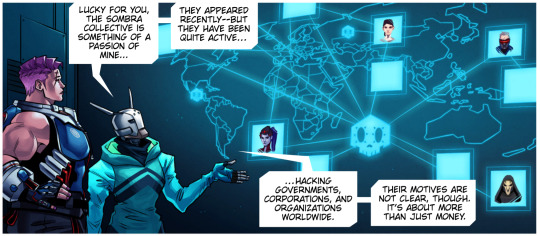
The new comic gave us a lot of great details to work with - some of it takes a little digging, some of it is speculation, but it feels like, after a year and half of slow, steady story and world-building, constructing the “details” is finally paying off for Blizzards. This comic had so much to work with, and you can tell that the writers and the artist were so dedicated to making it feel like the most in-universe, grounded comic yet.
To start off with, I’m going to present a few things.
First, you should read these, if you haven’t already:
http://segadores-y-soldados.tumblr.com/post/164852538245/overwatch-companies-and-corporations
http://segadores-y-soldados.tumblr.com/post/164417776210/devil-in-the-details
http://segadores-y-soldados.tumblr.com/post/163200042035/death-becomes-you
You should also have this:
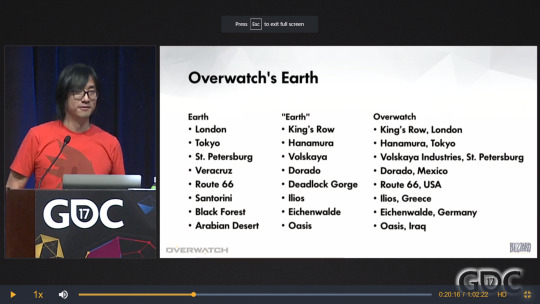
(I’ve seen a lot of people get confused on things like Volskaya’s location vs the “Krasnoyarsk Front, Russia,” where Dorado is, etc. These are straight from Michael Chu himself. The columns go: [Real world locations] > [the versions that Blizzard wanted to make for the game] > [the end “combination”])
And finally, a rough timeline of where “Searching” fits in with the rest of the current events in the Overwatch plot:
[Infiltration] > [“Searching” begins] > [“Masquerade” comic occurs (approximately late February, around Carnival in Venice)] > [“Searching” continues] > [Doomfist attacks Numbani] > [Efi makes Orisa] > [Zarya arrives in Numbani]
This essay will be operating on the premise that Sombra and Reaper are working together in some fashion, specifically that they are working on either 1) uncovering the conspiracy that Talon is a part of together and/or 2) to bring down Talon together and/or to take over Talon together.
Let’s begin.
Corruption in Corporations

It was fantastic to see that the very first thing Zarya did was make an effort to seek out major corporations that could have been affected by Sombra. Recall that at this point, most of the world knows that Sombra targeted LumériCo in an effort to reveal corruption by Portero and his corporation to the world.
The Sombra ARG also highlighted that Portero had direct connections with individuals in two other major corporations - Sanjay Korpal of Vishkar, and Katya Volskaya of Volskaya. We don’t know the exact nature of these connections, but in “Companies and Corporations,” I write that the larger thematic issue we are being shown through these three companies in particular is that corruption runs in circle - a “network” of mismanagement, power, and control that results in profits for those at the top.
If anything, this comic reaffirms that idea, as Zarya works through her own list of “leads,” starting with a company that has quietly flown under the fandom “radar” - Lucheng Interstellar.
With the narration by Winston in the video, we have a better understanding of the unethical, probably inhumane treatment of the gorilla troop that lived in the moon colony. The gorillas were subject to injections that gave them the intelligence of at least humans, and they were seemingly subject to some harsh rules. Emails in the “New Details Emerge About Possible Fate Of Horizon Lunar Colony” article (https://playoverwatch.com/en-us/blog/20812209) show that the gorillas (or “specimens”) were often put in “in their rooms” when they acted up. At the very least, one “speciment” (Hammond) was put in a cage.
Lucheng is suspicious for their probably unethical treatment of animal test subjects, the “genetic manipulation” of them, and their radio silence on the issue for what is apparently several years.
Lucheng has yet to play a “huge” role in the current Overwatch plot, but they do feature into the background of Winston, whose narration for the Horizon Lunar Colony map details some unethical and likely abusive experiments against the gorilla troop living on the moon. Lucheng’s central control room is also one of the KOTH maps for Lijiang Tower, though no real explanation is given as to why people are fighting over the room.
Does Katya have connections to Lucheng? Hard to say at this point, but rather, the detail of Zarya thinking that Sombra might have an interest in the company is a telling one, one that the comic dances around until the very end:
Though she does not fully realize it, Zarya is actually more suspicious of the looming power figures in the world than her “enemies” - Omnics...and Sombra herself.
Before I get more into that, I’d like to mention that I was thrilled to see a certain “corruption CEO” make an appearance:

I’ve said for quite some time now that the motifs behind Portero and LumériCo are representative of a really cool, really interesting concept grounded in Mesoamerican mythology, specifically Aztec and Mayan stories and world concepts. Seeing this panel just confirms that the idea is still present.
Dorado itself was rather blindly (hah) designed by the Overwatch team who, in their haste to make a “bright, colorful village map,” drew references from an Italian city by the sea (gj guys, way to double-check your sources). But the LumériCo power plant was almost certainly designed based on the Laguna Verde Nuclear Power Plant, which exists in almost the exact same location as Dorado’s maps (note that the in-game map within the LumériCo appears to be incorrect, as the Uprising map confirms that Dorado is supposed to be further south on the Gulf of Mexico). More than anything else, the LumériCo power plants are designed to evoke the pyramids of Aztec and Mayan design. These were massive stone builds of ritual, political, and social power that were meant to mimic the mountains that gods such as the Feathered Serpent, Tlaloc/Chaac, and Huitzilopochtli were believed to live on. They were also meant to be displays of power and regality by various kings, queens, and rulers.
So like the Temple of Anubis, the LumériCo power plant is a remixing of “real world mythologies” with the dev team’s “vision of the future,” a vision where humanity celebrates its diversity and the beauty of its multitude of ideas and histories with a “futuristic twist.”
But what it also implies is that Portero - the CEO of LumériCo - is imposing himself as a psuedo-ruler in Mexico.
From here: http://segadores-y-soldados.tumblr.com/post/159665523340/overwatch-apocalypse-now
The entire Sombra ARG was about Sombra attempting to “dethrone” Portero. This isn’t even subtext or close reading - this is literally how Sombra herself describes her actions:
“The King Guillermo Portero of LumériCo invites cordially, his loyal servants, to participate in his crowning event and to celebrate his infinite greed and treason toward the people of México. We gave coordinated the publication of info that demonstrates that Portero is a viper, that have for a long time ripoff the riches of our country for his own wealth. He has corrupted our government, turned our sisters and brothers into beggars, and he won’t stop until controlling the whole country under his dominance. But we, Los Muertos, won’t tolerate the celebration of his reign of corruption. We’ll demonstrate to our new conquistadores (conquerors) who will take the reins of the future of our country! On November 1st, we’ll dethrone the King Viper and we’ll celebrate the recovery of our home.”
Zarya references this fact as well, on the next page of her comic:
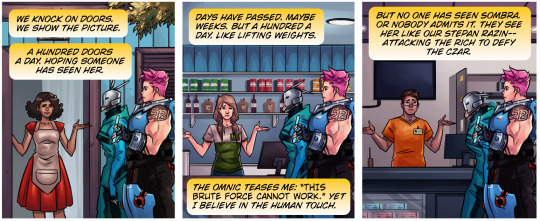
Here, she talks about Stepan Razin, who led a popular uprising against the Tzardom and nobility of Russia in the 1600′s. The implication of these three panels is that everyone in Dorado (save LumériCo) knows who Sombra is, but they aren’t telling Zarya and Lynx because they support Sombra’s actions.
This is important
because Zarya is the exact same type of “popular folk hero” to the people of Russia as Sombra is to the people of Dorado.
From Zarya’s hero profile:
Aleksandra Zaryanova is one of the world's strongest women, a celebrated athlete who sacrificed personal glory to protect her family, friends, and country in a time of war.
Now she serves—a symbol to some, a stalwart fellow soldier to others. But for Aleksandra, it is a chance to use her great strength to protect the ones she loves.
Though subtle, we start to see some of the doubt being cast over Zarya about her actions, the things Katya told her, her interactions with Omnics (and Lynx specifically), and this seemingly wild goose chase she’s been put on.
Is Zarya’s power helping the people...or is it helping something more sinister?
Soldier or Hero?
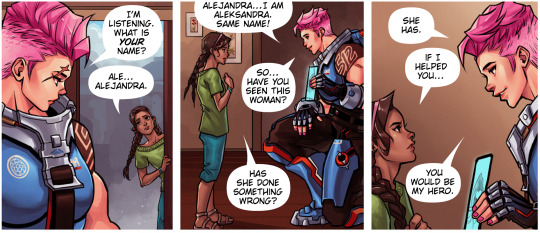
I think I actually gave an audible gasp at this point.
This is where we can see the details of Blizzard’s slow, almost painfully deliberate world-building process start coming together.

These sets of panels are a great reference to the “Hero” animated short, and show us how everything in the Overwatch story - every line, every action, every idea - has a ripple effect. It’s been about a year and a half since the “Hero” animation was released, and, in theory, about approximately the same amount of time has occurred “in-universe” in the main Overwatch plot (“Recall”/“Alive,” “Hero,” and “Dragons” all occur approximately at the same time as the game’s official release, with “Recall” leading right into the “Are you with us?” message Winston sends to “agents” aka players).
At the end of the “Hero” animation, we see that Soldier: 76′s actions of fighting Los Muertos members and saving Alejandra has resulted in her being inspired to be braver and more heroic.
Alejandra: You’re one of those heroes...aren’t you?
Soldier: 76: ...Not anymore.
Alejandra: ...I think you are.
And finally
FINALLY
after all this time
we see some of that pay off.
In “Searching,” one of the Overwatch main cast finally comes in contact with Alejandra, and what do you know -
It happens to be the woman with the same name.
“Aleksandra” and “Alejandra” are both linguistic derivatives of the feminine form of “Alexander” - “Alexandra” in English. All of these names generally stem from the most famous “Alexander,” Alexander the Great, the often romanticized Macedonian general and king who founded one of the greatest empires in antiquity. Names deriving from Alexander are meant to inspire thoughts of heroism, bravery, courage, and -
Oh yeah -
The name Alexander is derived from the Greek Ἀλέξανδρος (Aléxandros), meaning "Defender of the people" or "Defending men" and also, "Protector of men", a compound of the verb ἀλέξειν alexein, "to ward off, to avert, to defend"and the noun ἀνήρ anēr, "man" (GEN ἀνδρός andros).
So, inherent in her very name, we see Zarya’s dilemma arise again:
Who is she defending? The people? Or those already in power? Who is she “a friend” to?
These panels between Aleksandra and Alejandra are great for highlighting a major turn-around moment, for both characters: Aleksandra shows her charm, her kindness, and her patience, getting down on the same level as Alejandra, telling the girl that if she helps her, Alejandra “would be her hero.”
And as we know, being heroic is what Alejandra wants and believes in more than anything else.
We can even see some of the hesitation here: Alejandra, who presumably knows Sombra as all the other people of Dorado do (by her civilian name), is reluctant to give away Sombra’s information (Sombra also has a line on the Dorado map about “stopping by the bakery,” implying that she knows Alejandra and her mother or at least sees them on a regular basis). But Alejandra makes the decision to “be a hero” and explain where Zarya and Lynx can find Sombra, especially because Sombra has “done something wrong.”
Connecting the Dots
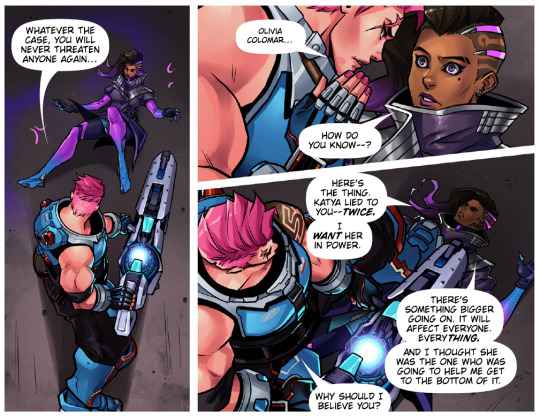
“There’s something bigger going on. It will affect everyone. Everything.”
“Why should I believe you?”
“Hahahaha, listen, mi amiga. Between me and Katya, one of us hasn’t lied to you.”
This is, by far, the most cryptic part of the comic. Why does Sombra want Katya to have considerable social and political power in Russia? Hell, even real military power, when you consider her mechs?
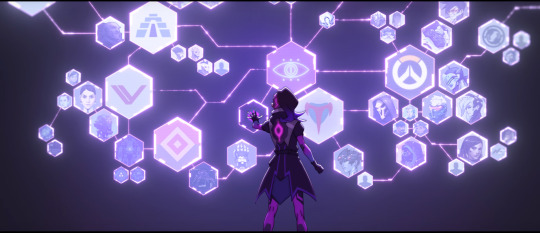
Since all the Overwatch characters are unreliable narrators, you can’t always take their word at face value. We do know that Sombra believes Katya should stay in power - we saw this in “Infiltration.” So at the very least, she believes Katya is of more use alive rather than dead.
What we need to look to next is other clues that we have. And the biggest one is Sombra’s version of her interconnectivity/relationships web.
So we also know that there’s a conspiracy - probably the “something bigger” Sombra tells Zarya - represented by The Eye symbol at the center of Sombra’s web. And the “corrupt” corporations like Volskaya and LumériCo are connected to it, along with “a group” in Numbani, Talon, and even Overwatch.
It’s difficult to say at the moment if The Eye represents the Talon council alone, or something “much bigger,” which it is definitely looking like.
Remember what caused the original Crisis?
A corporation that got caught up in fraud and corruption.
Doomfist’s goal is to bring about a global conflict that will drive both humanity and Omnics to be “stronger.” His ideology is a twisted form of Social Darwinism, but if you’ve read some of my other stuff, you’ll know that he’s not “wrong” in the sense of history. Forcing conflicts helps a very select group of people:
The Military-Industrial Complex.
This is a term to describe the people, groups, corporations, technologies, and industries that “profit” off of war. Typically, these are weapons manufacturers or defense companies that produce the supplies needed in wartime endeavors...
(From here: http://segadores-y-soldados.tumblr.com/post/164852538245/overwatch-companies-and-corporations)
It is tantalizing to speculate beyond this, but at the moment, it’s not clear who or what exactly is involved in this. Rather, I would say that Doomfist’s “revitalized” Talon’s goal is to set out to create a conspiracy “network” that enmeshes many of the larger corporations and organizations into a unified “conflict” organization that can create wars whenever they need to.
And before people jump at this, remember.
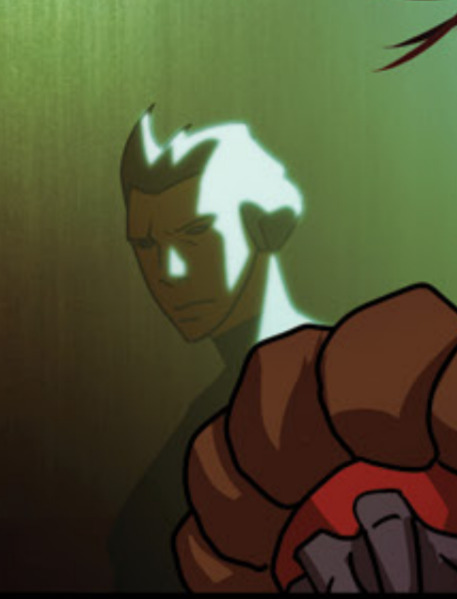
Doomfist already has one “corrupt corporate” member on his council.
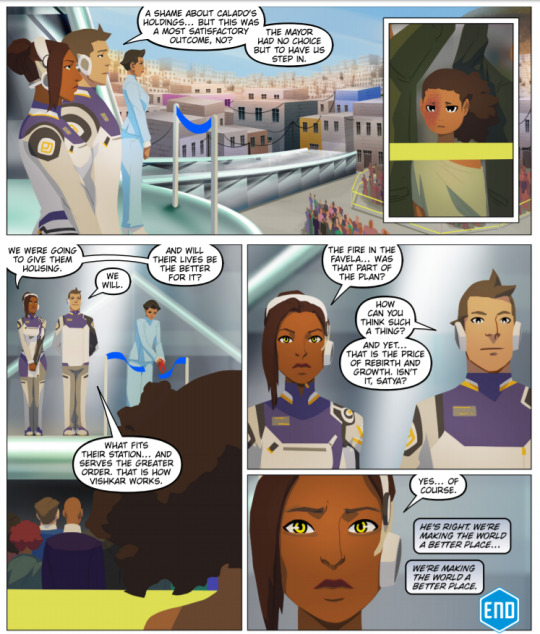
Sanjay Korpal...
Who has connections to Guillermo Portero...
Mr. Portero,
I have conveyed the contents of our latest discussion with the executive directors and they are all in agreement in principle on the framework for a deal. Of course there will be a lot of discussion and communication in the coming days, but I am optimistic that we can reach a mutually beneficial understanding.
I understand your concerns over the recent press about our Rio de Janeiro development, however I can assure you that this is just a blip on the radar and that we are taking care of it. And of course, we are more than happy to keep our negotiations private until such time that you feel comfortable in discussing them with the public. And of course, we are more than happy to assist with smoothing over any conflicts that might come up in opposition of our proposals.
Sincerely, Sanjay
Who has connections to Katya Volskaya.
The Sanjay link is a big deal. I’m not going to say that Guillermo and Katya are “part” of the Talon council until we have further proof of their direct involvement. But at the moment, they look like they might be...beneficiaries of some sort of overarching protection, possibly “enforced” by Talon.
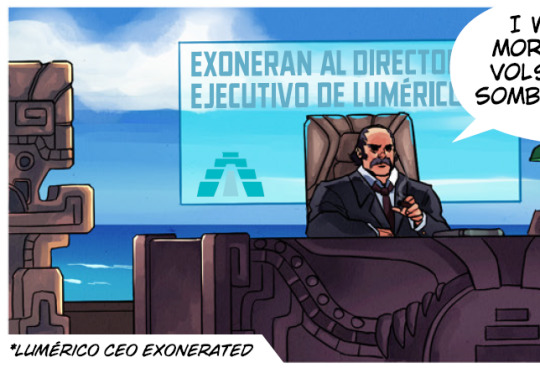
I’ve seen almost no one comment on this, but Portero being exonerated “of his crimes” and then reinstated as the CEO of LumériCo is a major detail -
Because, in theory, it “undoes” all of the work of Sombra’s email leaks.
Sure, yes, it could mean that Portero never actually did anything wrong. But no one believes that at this point. Even if Sombra is an unreliable narrator and her motivations are not “just” or “noble,” we still have his emails, his shaky connections to Volskaya, the weird power plants, the psuedo-Mesoamerican-styled “pyramids of power.” Even Soldier: 76 is suspicious of him.
And of course, we have his connection to Sanjay, and therefore to a member sitting directly on the Talon Council.
And this is another great detail of the Zarya comic:

Almost everyone “in power” is corrupt in some way.
Zarya should not be able to go to the police of another country, ask for highly sensitive details on a black market hacker, and get vague promises of being shared results. (And in the background, Omnics are being “herded” somewhere.)
Absolute power corrupts absolutely. And corruption bleeds down to everyone.
This is a thematic issue that we will see repeat itself time and time again - that corrupt companies and corporations are undermining global stability and peace, whether directly or indirectly.
Corruption and the misuse of power are not “structural, hierarchical ladders” in the world of Overwatch.
Corruption and the misuse of power are circular, connected, linked together -
into a spider’s web.
What is also great about the Zarya comic is that we get a new web to double-check Sombra’s against.

We have to keep in mind that Lynx’s web is a little bit different - Lynx is an outsider “looking in” at the pattern of Sombra’s attacks and her connections. Lynx seemingly has “no connections” to the larger story, but they do come “recommended” by Katya.
But Lynx’s web does give us some insight because it offers some minute locational data that Sombra’s web does not.

Yellow simply represents a direct “line” to Sombra, whatever that line represents. Red represents secondary lines of connection (again, whatever that means specifically). The blank box connected to Soldier: 76 is likely Ana, who Sombra is already aware exists. Lynx’s web might not know who Ana is, but might call her by her bounty hunter name, “The Shrike.” One of the other blank boxes with a direct link to Sombra might be Doomfist.
Remember, this could be Lynx’s “speculation.” It’s difficult to say.
In my opinion, the most interesting part here isn’t actually the Soldier: 76 - Sombra link, but the weird triangle connected in the top.
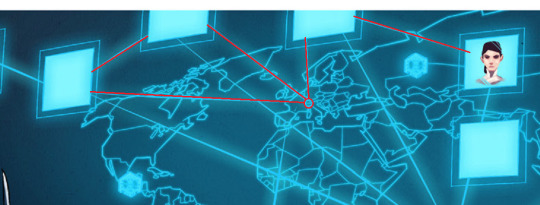
Katya has direct ties to one of these individuals (possibly Portero), who - along with two others - have connections to a circle around...
Switzerland?
Now, before people jump up about Chateau Guillard and Annecy -
Widowmaker’s line actually terminates at a specific location in the web.
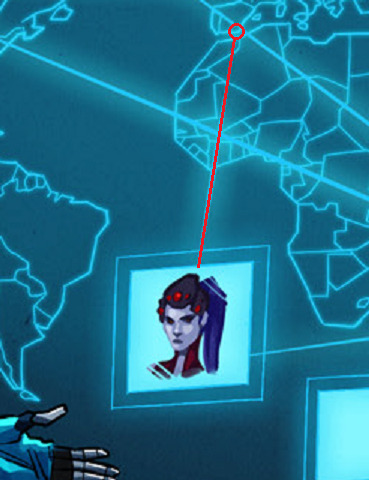
Yup.
That’s probably Gibraltar.
Which is weird, because we have no reason to believe she’s been there. In fact, Reaper has been to Gibraltar “recently,” when he went to steal the Overwatch agent list from Athena and “inadvertently” caused Winston to initiate Recall.
So believe me, I’m just as confused by this as you are. I don’t know what it means. I don’t know if this is an error and Reaper and Widowmaker’s portraits in Lynx’s web were misplaced. I don’t know if it means something more. For now, I’m taking Lynx’s web with a grain of salt.
What we do know is that there are three individuals or groups that Sombra has “hacked” or made some sort of connection with who have ties or their own connections to something or someone in Switzerland.
Which, I mean.
These maps of “active Overwatch investigations/areas of interest” from the “Uprising” comic provide additional support for the circle on Lynx’s web being something related to the Swiss Base Watchpoint.

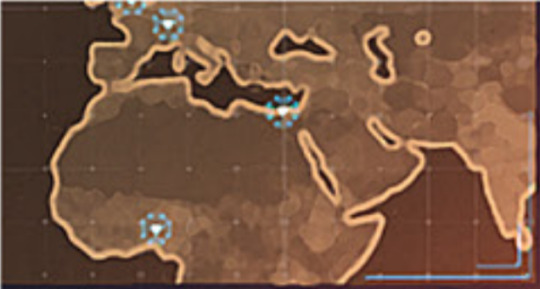
Could Blizzard tease us any harder?
Even if she herself isn’t looking at people with direct connections to the fall of Overwatch, Sombra is actively investigating people with ties to Switzerland. Which is very interesting when you consider that two of the people who have portraits and “direct lines” to Sombra

Are also actively investigating people with ties to Switzerland - specifically, the fall of the Swiss Base. Reaper’s investigation of the matter is more hypothesized/speculated (again, this essay assumes that the hypothesis that Reaper and Sombra are working together “in some way” is correct), but Soldier has actually stated multiple times that he’s trying to figure out “who caused the fall of Overwatch.”
Now -
Lynx doesn’t know any of this.
Hypothetically, this makes Lynx an unbiased source. Again, take all that with some skepticism - Lynx was recommended by Katya, and they were also hacked by Sombra while Zarya and Lynx were still in Numbani (we don’t know when exactly). So “biased” vs “unbiased” is very loose here. But I do think we can at least use Lynx’s web to explore some theories.
Lynx might suspect that Soldier: 76 is Jack Morrison - hell, the entire world of Overwatch “suspects” it at this point (https://playoverwatch.com/en-us/blog/19809396/), but Lynx has no idea who Reaper is, and what his connections to Sombra are, just that the two work together “for Talon.”
But we the audience know that isn’t entirely true.
Michael Chu has stated that the only people who know Gabriel Reyes is Reaper are Soldier: 76/Jack Morrison, “The Shrike”/Ana Amari -
And Sombra.
Therefore, Sombra’s in-game interactions with Reaper can be considered “canon.”
Sombra: What's the plan today, Gabe? You don't mind if I call you Gabe, do you?
Reaper: Stick to the mission.
Reaper: Try to stick to the plan, Sombra.
Sombra: Look, someone has to be ready when all your careful planning doesn't pan out.
And that includes this fun little tidbit on Oasis:
Sombra: So what are we doing here, boss?
Reaper: I need to pay a visit to a friend.
If you’ve read my other essays, you know that I generally support the theory that Reaper is in Oasis to visit Mercy, or someone connected to her. Mercy’s last known location as of Recall was somewhere in the Arabian Peninsula, “close” to Oasis’ location.

Based on the “Reaper sightings” map on Necropolis, Soldier: 76 and Ana are also aware that Reaper has been to Oasis (these locations are: Los Angeles in “Reflections,” Gibraltar in “Recall,” Numbani in the Museum Heist trailer, St. Petersburg in “Infiltration,” and Oasis for some reason).
I would argue that, even if they have their differences, there is a tentative trust between Reaper and Sombra - he trusts her enough to bring her along on his “personal mission” in Oasis, and we know they “have a plan” together.
I will posit the hypothesis that Sombra is feeding information about Reaper to Soldier: 76 and Ana, though I don’t know how much I buy it myself. Either way, the breadcrumbs are there, if you wish to make that connection. I just find them a little too thin, even for my own speculating, conspiracy-lovin’ ass.
No matter what, I will agree that Sombra is at the center of a movement to try and “bring down” a major, global-politics-dominating conspiracy, which may have had a hand in destroying Overwatch.
Which Katya has “some sort of connection to.”
This is alluded to at the very end of Zarya’s comic, in which Zarya has - much like Reaper - decided to tentatively trust Sombra over Katya. It is not known if Sombra somehow gave Zarya more information, or promised to, but at the very least, Zarya seems to have pieced together that “something bigger” is happening with Katya - “something bigger” than just using Omnic technology in her mechs.
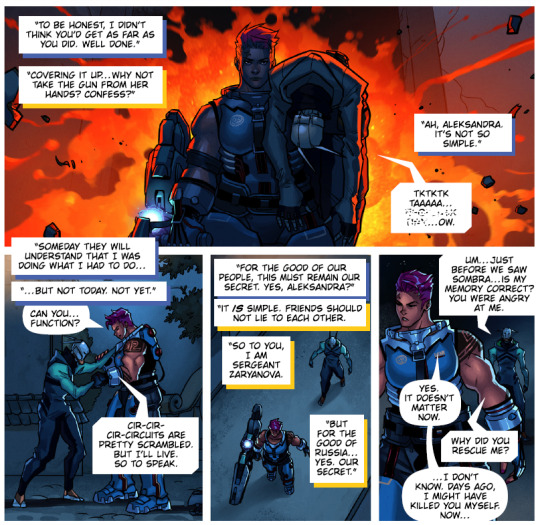
The dialogue here gets really awkward with the layout, so I’ll try to give a direct transcription, and then my interpretation of it.
Direct:
Katya: To be honest, I didn’t think you’d get as far as you did. Well done.
Zarya: Covering it up...Why not take the gun from her hands? Confess
Katya: Ah, Aleksandra, it is not so simple. Someday they will understand that I was doing what I had to do...But not today. Not yet. For the good of our people, this must remain our secret. Yes, Aleksandra?
Zarya: It is simple. Friends should not lie to each other. So to you, I am Sergeant Zaryanova. But for the good of Russia...Yes. Our secret.
There’s a ton to unpack here. I’m going to give my interpretation/rewrite of the lines first.
Interpretation:
Katya: To be honest, I didn’t think you’d get as far as you did. Well done.
Zarya: Hiding the truth...Why don’t you simply admit to the public where you get your tech from? Take the “gun” from Sombra’s hands?
Katya: Ah, Aleksandra, it is not so simple. They won’t understand that I was doing what I had to do. Maybe someday, but not today. For the good of our people, this must remain our secret. Yes, Aleksandra?
Zarya: It is simple. Friends should not lie to each other. So to you, I am Sergeant Zaryanova. But for the good of Russia...Yes. Our secret.
What’s happening is that there’s a very interesting implication of “something more” lurking behind Katya’s words - that if she admitted she got technology from Omnics to the people of Russia, “something bigger” might come out.
(I also wanna say that I love the return to the lines on the first page here - the reference to “friends not lying to each other,” “I am Sergeant Zaryanova” vs “Aleksandra,” “it is (not) simple,” etc. Even if the layout of the dialogue is awful, the actual writing is wonderful.)
What is also implied is that, very subtly, Katya and Zarya have settled on different meanings of “for the good of Russia.”
While Zarya is willing to keep the secret about the Volskaya mechs - and possibly “something bigger” - in order to maintain some sort of peace, she recognizes that her own goals are for the people, whereas Katya’s goals are for herself. We have come back to Zarya’s biggest dilemma:
Who is she defending? The people? Or those already in power? Who is she “a friend” to?
I don’t think it’s a coincidence that Michael Chu has danced around the word “friend” with regards to Sombra and her “allies” within Talon. Specifically, Michael Chu has said that Sombra considers Reaper and Widowmaker “friends,” though to Sombra, “friends” and “enemies” are not so different.
It seems, then, at that the end of this comic, Zarya has come to a similar sort of conclusion.
Omnics can be good allies.

Her “heroes” can be corrupt.

Her “enemies” can tell the truth.

And her “war” -
Her fight -
Can be for “something bigger” than her country.

What does it take to make a hero?
Strength?
Courage?
Power?
Perhaps it is the ability to do what is right.
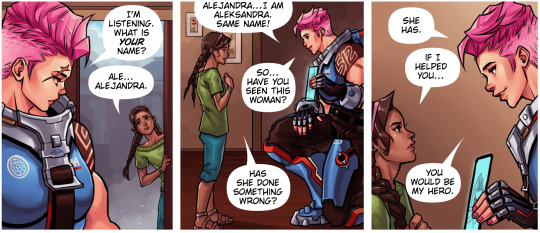
#Zarya#aleksandra zaryanova#overwatch lore#overwatch theories#searching comic#my essays#katya volskaya#alejandra#sombra#reaper#soldier 76#long post
402 notes
·
View notes